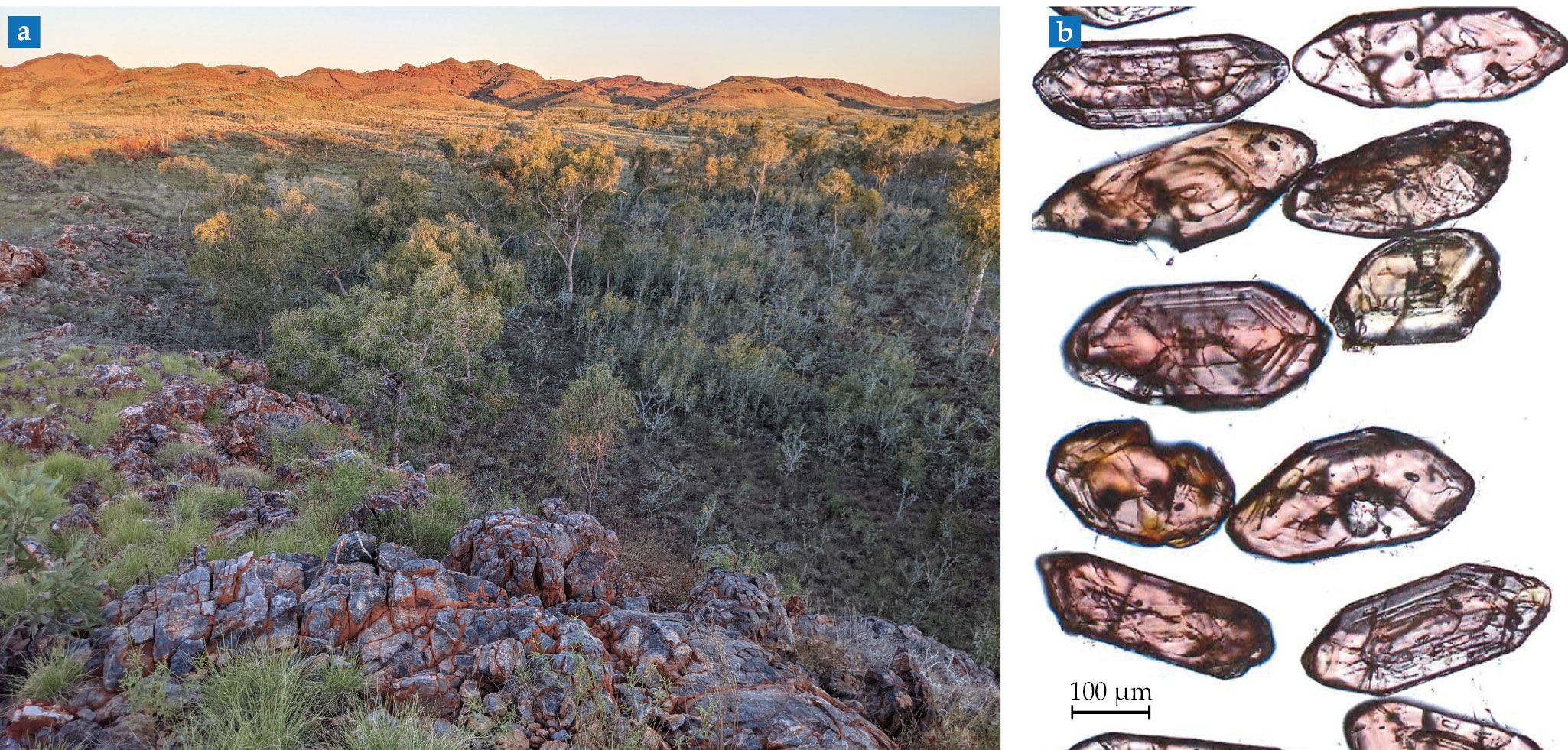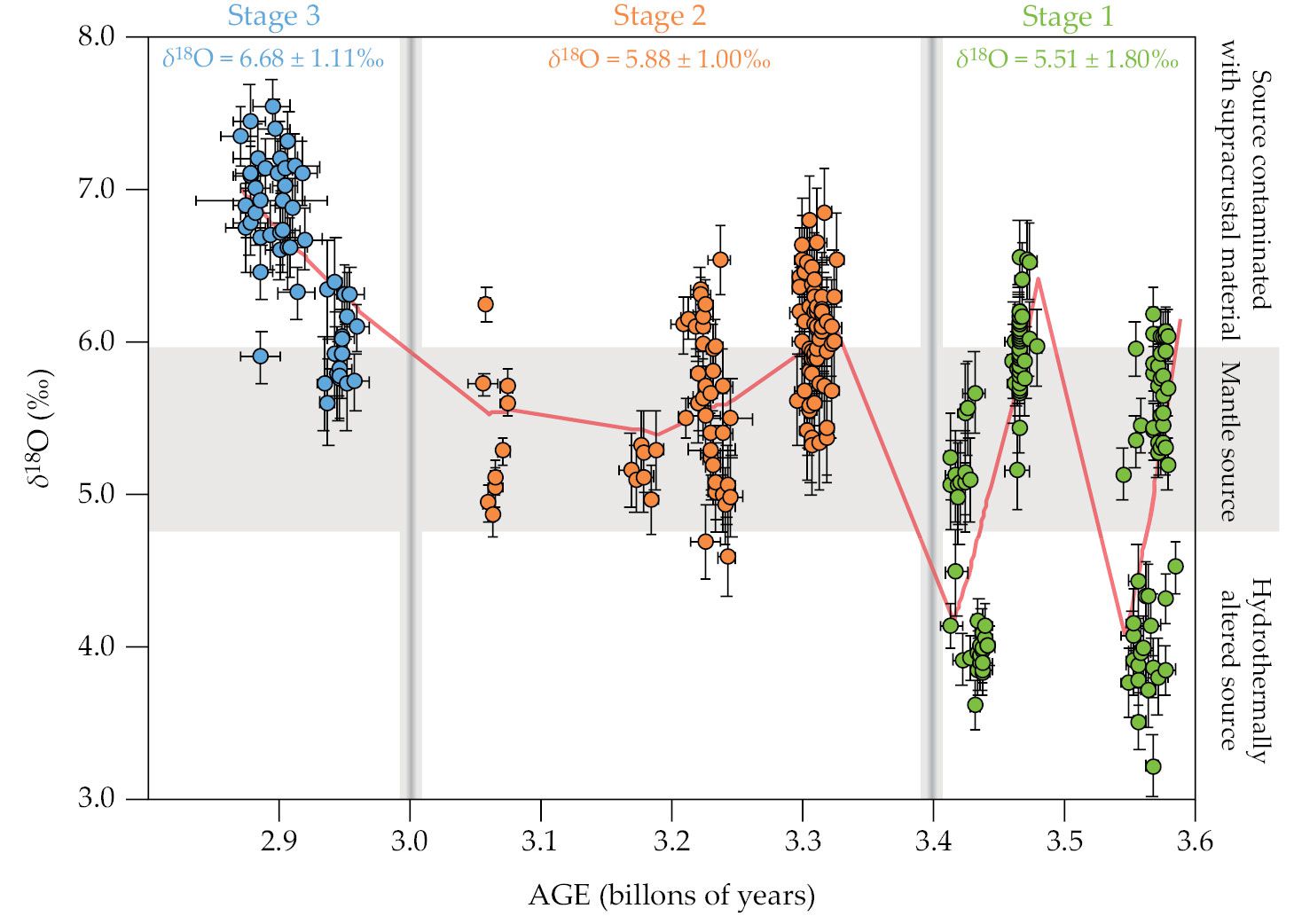Giant meteorites could be responsible for Earth’s continents
DOI: 10.1063/PT.3.5095
The Pilbara craton, in the Pilbara region of Western Australia, is the best-preserved remnant of Earth’s ancient continental crust (see figure
Figure 1.

The Pilbara region of Western Australia hosts the best-preserved fragment of Earth’s ancient continental crust. (a) The Pilbara craton formed as far back as 3.6 billion years ago, around the same time as most of today’s landmass. It is one of a handful of locations where geological processes between the rocks’ formation and the present day haven’t erased mineral markers of their origins. (b) Zircon grains extracted from Pilbara rocks are particularly useful measures of the craton’s past because their composition reveals their age and the conditions at the time of their formation. (Images courtesy of Chris Kirkland.)

Most present-day oceanic crust is at most 200 million years old, and its formation is ongoing and well understood: When a gap opens between tectonic plates, magma bubbles up into the gap, cools, and spreads out from the initial ridge. Continental crust is much older; three-quarters of the present-day landmass worldwide formed in the Archean as did the Pilbara craton. Because the continents have been around so long, figuring out their genesis is a challenge. Earth’s geological evolution gradually and often violently transforms and mixes continental crust until evidence of the distant past is erased.
Since the mid 1960s, one theory has argued that continents formed at the sites of collisions with asteroids tens or a couple hundred kilometers wide. 1 The resulting heating and excavation of the primordial crust would have triggered a sequence of events in which the melted mantle swelled up and overfilled the crater to create a plateau. That seed would then have grown into a continent.
The idea makes chronological sense; the solar system saw a barrage of asteroids around 3.9 billion years ago, a period known as the Late Heavy Bombardment. The Moon’s craters are evidence of that period (see the article by Brett Denevi, Physics Today, June 2017, page 38
Now Tim Johnson of Curtin University in Australia and his colleagues have found support for the theory that continents formed at the sites of giant impacts. 2 They show that the isotopic composition of Pilbara craton rocks matches what’s expected if an asteroid hit the region. Their description of how the craton emerged may explain not only the Pilbara’s formation but the making of Earth’s continents.
Rock of ages
Johnson, who hails from the UK, arrived in Western Australia in early 2014, just after he had begun thinking deeply about early Earth—that is, the first billion or so years of its four-and-a-half-billion-year existence. He soon met Hugh Smithies of the Geological Survey of Western Australia (GSWA), a division of the state’s Department of Mines, Industry Regulation, and Safety. The GSWA was founded over a century ago to gather geological information.
Smithies had long been researching ancient rocks from the Pilbara craton and elsewhere in Western Australia. Those rocks offered an ideal way to study early Earth. Over the course of nearly a decade, Smithies, Johnson, and their collaborators teamed up on a series of projects that used data from Pilbara craton samples. The new study, a culmination of that work, started when Smithies and Yongjun Lu, also from the GSWA, went to Curtin University to discuss some intriguing recent data with Johnson and his colleague Chris Kirkland, an expert on isotope geology.
The team used secondary-ion mass spectroscopy on 26 Pilbara craton rocks that were 2.9–3.6 billion years old. The measurements focused on grains of the magmatic mineral zircon (shown in figure
Figure 2.

Oxygen isotopes in zircon reflect the source materials that formed the mineral. The ratio of 18O to 16O in secondary-ion mass spectroscopy measurements is compared with a standard reference of distilled seawater to find a relative difference δ18O in parts per thousand (‰). A useful benchmark is the δ18O of Earth’s mantle (horizontal gray stripe). As indicated by a local regression fit (pink line), zircon grains from the Pilbara craton have δ18O values that trend with decreasing age, given in stages separated by vertical gray lines, from lower than the mantle in stage 1 (green) to mantle-like in stage 2 (orange) to higher than the mantle by stage 3 (blue). A giant impact could explain the trend. (Adapted from ref.

The team wondered whether a giant impact could explain the observation. A strong sign would be that the oldest zircon grains show evidence of forming not from mantle-derived magma originating deeper in Earth but from surface materials melted together by the exceptional heat and compression of an asteroid impact. Such a collision would also produce a whole series of events with potentially discernible influences on the oxygen isotope ratios.
Watered down
The researchers investigated the 18O/16O isotope ratio of the zircon samples relative to Vienna Standard Mean Ocean Water, a pure-water benchmark distilled from ocean water gathered from around the globe (see Physics Today online, “Setting standards with old rocks and ocean water
A useful point of comparison is Earth’s mantle: Its δ18O, shown as a gray horizontal stripe in figure
Johnson and his colleagues found that for zircon grains older than 3.4 billion years, which they named stage 1, a third have ratios less than that of the mantle. Zircon ages 3.0–3.4 billion years (stage 2) have a higher median δ18O than that in stage 1, with more than half of the ratios falling in the range expected for the mantle and nearly all the rest higher. For the youngest zircon, with ages less than 3.0 billion years (stage 3), more than three-fourths have δ18O higher than the mantle.
Johnson and his colleagues argue that the data fit with what would be expected from a giant impact. The low δ18O values in stage 1 indicate a material source near Earth’s surface that was hydrothermally altered at high temperatures, as expected if a burning meteorite crashed into, cracked, and melted a primordial crust covered with ocean water.
The heating and compression from such an impact would spread down to the mantle, which would melt and eventually swell up to fill the crater until it becomes a plateau. That continental nucleus would have crystallizing magmas at its base, which would melt to produce granites with the mantle-like isotope ratios seen in stage 2. Finally, in stage 3, dense near-surface rocks, with their higher δ18O, would sink and end up in a process of intracrustal recycling sometimes called sagduction, akin to subduction but without tectonic plates. From there that continental nucleus would grow.
Additional evidence supports the idea that giant impacts occurred in the region. The Pilbara craton has what’s known as spherule beds, a layer of spherical sediment droplets. Spherules are commonly believed to arise from ejected liquid or vaporized rock from a giant impact. The oldest spherule beds in the Pilbara are about 3.4 billion years old, which reassuringly is the same age as a large cluster of low δ18O zircon grains.
Johnson says that some researchers have been reluctant to accept that giant impacts shaped our planet in any appreciable way, so he suspects that the new work will face opposition in the community. “I’m hoping that the research will stimulate vigorous activity among several groups that will be keen to prove us wrong,” Johnson says. “The early Earth is a very controversial scientific endeavor. We’re talking about so long ago, and the rocks are so old and have undergone such an uncommonly violent subsequent history.”
Any alternative explanation would need to fit the data as well as a giant impact does, though. Two popular alternative theories—that hot matter bubbled up from the mantle to form a continental seed or that plate tectonics were already at play in the Archean—both predict the oldest zircons would have origins from deep below the surface and thus have mantle-like δ18O values.
Johnson and his colleagues’ next step is to investigate other well-preserved ancient rocks in northwest Canada, southern Greenland, and a few other territories to see whether giant impacts could explain all continental masses, not just the Pilbara region. Their initial look at data from the Slave craton in Canada is promising.
References
1. J. W. Salisbury, L. B. Ronca, Nature 210, 669 (1966). https://doi.org/10.1038/210669a0
2. T. E. Johnson et al., Nature 608, 330 (2022). https://doi.org/10.1038/s41586-022-04956-y
3. J. W. Valley et al., Contrib. Mineral. Petrol. 150, 561 (2005). https://doi.org/10.1007/s00410-005-0025-8
